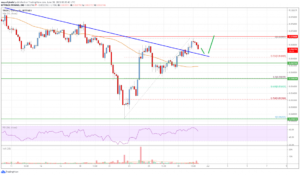Fort Triumph was a long, hard struggle. It happens occasionally with a review: you get a game that doesn’t stick with you, but you’ve got to resolutely press on. But it’s not necessarily because Fort Triumph is bad. In all honesty, I think that it will find an audience, and objectively it does a number of things well. But it makes decisions that rub me up the wrong way – things I just don’t enjoy in video games – and I couldn’t bring myself to choose its icon on the dashboard. To me, Fort Triumph is that person my friends all like, but I just don’t get on with.

Fort Triumph is a turn-based strategy game, and anyone who’s fallen under the spell of X-Com and Heroes of Might & Magic will be right at home here (as a note, that’s not what we butted against: we love the genre, and would probably tuck it into our top three). You have your squad of heroes, and you jump into differently terrained maps. An enemy squad is there too, and you take it in turns to spend Action Points on your choice of abilities. You might move into cover, put yourself into ‘overwatch’ so you can counter when an enemy moves, attack, or use an item. Then you’re watching the enemy turn play out, hoping they don’t gang-tackle your exposed archer.
Some things are expected, and some aren’t. You’ve got a wide variety of heroes to choose from, and those heroes are better at some things than others. Archers and mages can thunk a projectile into an enemy’s knee from a distance, while barbarians and warriors are better up close. That’s all very much by the book. But Fort Triumph has a level-up system that randomly offers three improvements for you to choose from, and those upgrades will have different rarities and might even be cross-class. That’s more unusual.
Another quirk is the destructible environments. There’s something of Red Faction about Fort Triumph, and your pyrotechnic abilities can obliterate houses and knock down trees. Both sides of the battle will use this to their advantage, as a fallen-pillar-to-the-head does significant damage and stuns the target. Games can devolve into a game of dominoes, where no-one attacks each other, and they instead topple trees. And it works really well, effectively giving you another thing to think about on the battlefield.
But perhaps the boldest decisions are in the procedural generation and permadeath. Fort Triumph opts to build all non-campaign missions (about ninety percent of what you’ll play) out of randomly generated building blocks, and it’s here that I bonked my head against my first low-hanging beam. Perhaps it’s because I spent so much time playing side-missions in Fort Triumph, rather than ploughing on with the more authored, better-designed campaign levels, but the levels became a generic mush. I like my turn-based strategy levels to be hand-crafted, with opportunities to outmaneuver. But in Fort Triumph, it feels like a battle in a Homebase parking lot. There’s some cars and shopping trolleys scattered about to provide cover, but there’s no level design; no real advantages of height or terrain to take advantage of. It’s just a jumble of cover opportunities, and I got a little bored, if I’m being honest.

Permadeath is another controversial one. Should your character die in battle, there’s only a few opportunities for revival, mostly baked into abilities and items, before they kick the medieval bucket. All of the levels and upgrades go with them, so you’re protecting your characters dearly. You’re not completely nobbled by a character’s death – a lot of your progression comes from your hub, so you get a base quality from your heroes – but it still smarts.
Permadeath on its own wasn’t the problem, though. We liked the higher stakes. It’s just that Fort Triumph, for a few reasons, doesn’t feel like it gives you full control of your characters’ fates, which means permadeath really hurts.
For one, Fort Triumph is extremely heavy on RNG. There’s no guaranteed hits or damage here: everything comes with a % chance, so you’re tossing a coin and hoping. Again, that by itself wouldn’t necessarily be a problem, but the rules around hit-chance seem to be all over the shop. I couldn’t tell you how cover generates roll-to-hit, and it certainly didn’t feel intuitive. And generally, you can’t anticipate what your % chance will be until you move into a combat position. More times than we can count, we flanked an enemy, got all smug, and then realised we had a 19% chat to hit for reasons that we couldn’t fully explain. So we died.
This is where the ‘it might just be us’ thing kicks in. There may well be rules, and there may be people who have discovered them, but Fort Triumph was a persistent enigma to us. Permadeath was always around the corner when we wandered into ambushes of our own making.
‘Gitting gud’ gets harder when characters are constantly dying and you forget what abilities are locked to each character. I’d pull off a killer move, only to remember that my magician Geoff wasn’t Geoff any more – they were Doug, and Doug didn’t have the paralysing attack that I planned to use. Cheers Doug.

I know we’re having a bit of a moan here, but Fort Triumph touches on so many things that I subjectively dislike about strategy games. Randomness has to be handled with real care if it’s going to work. It can easily slip into arbitrariness, and you have to give me real agency with it if I’m going to enjoy it. I never got close to that feeling with Fort Triumph. Procedural battles, through some kind of smoke and mirrors, need to feel like they were made by a real human being. But they don’t here. They feel like the products of algorithms.
There’s some stuff that I’d say is more objective than subjective. Fort Triumph is not your textbook PC port. Text is tiny, interfaces are small, and some controls – we’re looking at you, city UI – make them downright difficult to navigate. We felt like an ogre trying to mash buttons to get the result they wanted, and it often got ugly. Developers CookieByte have acknowledged that there are some issues with the general game readability, and are looking to improve things, but we can only go by the game we have in our hands.
These issues, some objective and some subjective, are mostly found in the turn-based strategy parts of the game, but there’s an entire other game wrapped around it. Between missions, you can explore a world map, zoomed out like King’s Bounty or a game of Civilization. It’s presented almost like a game board, and – similar to the strategy game element – you have a set number of squares you can move in a turn. So, you’re exploring a fog of war and uncovering hidden villages, abandoned chests, mini-events and combat encounters.
These sections were great. They have their rough edges, in particular the turn system which makes things clunkier than it has to be (real-time movement would have made this more joyful), and some AI characters keep messing with the stuff you’ve accumulated just to make you return to older areas, but the simple wonders of finding a landmark and exploring it feel good.

The moments between missions also allow Fort Triumph’s tone to creep in, which is refreshingly humorous. There’s a bit of wit and bawdiness here that’s welcome, even if it occasionally trips over itself when it tries to accommodate the many different characters you can have in any given situation. It can feel a bit like a story version of a chop-shop, with snatches of dialogue stapled together, but it raises more than the odd laugh.
Depending on how you play Fort Triumph, it can be surprisingly short for the genre – the campaign levels probably amount to eight hours in total – or it can be interminably long if, like me, you spend too much time wandering the world, grabbing magical junk and starting procedurally generated battles. In hindsight, perhaps the eight-hour approach was best: Fort Triumph is at its best when things move away from the random, and more towards the authored.
There will be people who love Fort Triumph. They will love the deep, replayable turn-based strategy game, and the partnering world-exploration game. But we are not those people. We found Fort Triumph to be in love with its own randomness, whether that’s the procedural levels or the percentage chance of leathering a goblin in the face. Thanks to the rolls of the dice, we never felt in control of our characters, and permadeath meant that Fort Triumph was a minefield that we got bored of walking through.
If your sensitivities to randomness and procedural generation are anything like ours, then we’d suggest switching back to X-Com. But if you’re less dismayed by the idea, then Fort Triumph might actually live up to its name.
You can buy Fort Triumph for £17.99 from the Xbox Store for Xbox One and Xbox Series X|S
TXH Score
3/5
Pros:
- Deep, strategic turn-based gaming
- World exploration sub-game is hugely satisfying
- Comedy is refreshing
Cons:
- Reliance on randomness gets infuriating
- Text is often too small
- Some control niggles
Info:
- Massive thanks for the free copy of the game go to - All in! Games
- Formats - Xbox Series X|S, Xbox One, PS5, PS4, Switch, PC
- Version reviewed - Xbox One on Xbox Series X
- Release date - 13th August 2021
- Launch price from - £17.99
- &
- 100
- Action
- ADvantage
- AI
- algorithms
- All
- around
- Attacks
- audience
- AUGUST
- Battle
- Battlefield
- Beam
- BEST
- Bit
- board
- build
- Building
- buy
- Campaign
- care
- cars
- City
- Coin
- content
- dashboard
- Design
- died
- discovered
- distance
- Enigma
- exploration
- Face
- First
- Fort
- Free
- full
- game
- Games
- General
- Giving
- good
- great
- head
- here
- Home
- hoping
- houses
- How
- HTTPS
- ICON
- idea
- issues
- IT
- jump
- laugh
- Level
- Long
- love
- Making
- map
- Maps
- Microsoft
- move
- moves
- Offers
- opportunities
- Other
- Others
- parking
- PC
- People
- press
- price
- Products
- ps4
- PS5
- quality
- raises
- real-time
- reasons
- review
- rolls
- rules
- Series
- set
- Shopping
- Short
- Simple
- small
- So
- spend
- Strategic
- Strategy
- Switch
- system
- Target
- time
- top
- ui
- us
- Video
- video games
- walking
- war
- WHO
- Work
- works
- world
- X
- xbox
- Xbox One
- Xbox Series X





